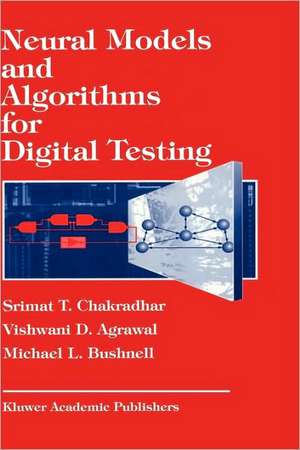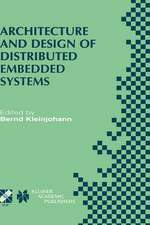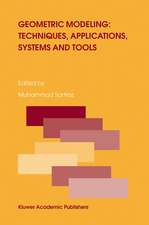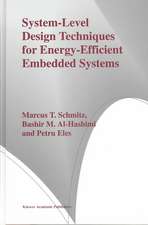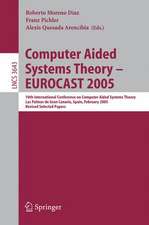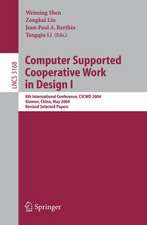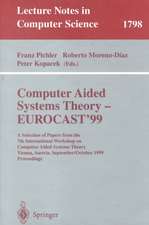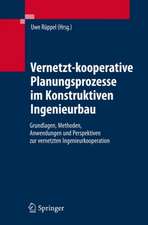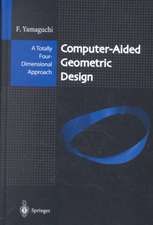Neural Models and Algorithms for Digital Testing: The Springer International Series in Engineering and Computer Science, cartea 140
Autor S.T. Chadradhar, Vishwani Agrawal, M. Bushnellen Limba Engleză Hardback – 30 iun 1991
| Toate formatele și edițiile | Preț | Express |
|---|---|---|
| Paperback (1) | 640.84 lei 6-8 săpt. | |
| Springer Us – 28 sep 2012 | 640.84 lei 6-8 săpt. | |
| Hardback (1) | 647.13 lei 6-8 săpt. | |
| Springer Us – 30 iun 1991 | 647.13 lei 6-8 săpt. |
Din seria The Springer International Series in Engineering and Computer Science
- 24%
 Preț: 1041.97 lei
Preț: 1041.97 lei - 20%
 Preț: 643.50 lei
Preț: 643.50 lei - 18%
 Preț: 1225.62 lei
Preț: 1225.62 lei - 18%
 Preț: 965.02 lei
Preț: 965.02 lei - 20%
 Preț: 646.12 lei
Preț: 646.12 lei - 18%
 Preț: 948.79 lei
Preț: 948.79 lei - 20%
 Preț: 646.62 lei
Preț: 646.62 lei - 15%
 Preț: 637.46 lei
Preț: 637.46 lei - 20%
 Preț: 643.83 lei
Preț: 643.83 lei - 18%
 Preț: 949.23 lei
Preț: 949.23 lei - 20%
 Preț: 644.48 lei
Preț: 644.48 lei - 20%
 Preț: 994.92 lei
Preț: 994.92 lei - 20%
 Preț: 645.97 lei
Preț: 645.97 lei - 18%
 Preț: 946.87 lei
Preț: 946.87 lei - 20%
 Preț: 995.57 lei
Preț: 995.57 lei - 18%
 Preț: 956.99 lei
Preț: 956.99 lei - 20%
 Preț: 644.98 lei
Preț: 644.98 lei - 15%
 Preț: 649.54 lei
Preț: 649.54 lei - 18%
 Preț: 950.21 lei
Preț: 950.21 lei - 18%
 Preț: 1221.38 lei
Preț: 1221.38 lei - 18%
 Preț: 957.62 lei
Preț: 957.62 lei - 15%
 Preț: 643.99 lei
Preț: 643.99 lei - 18%
 Preț: 948.47 lei
Preț: 948.47 lei - 18%
 Preț: 947.35 lei
Preț: 947.35 lei - 20%
 Preț: 1284.65 lei
Preț: 1284.65 lei - 20%
 Preț: 1633.95 lei
Preț: 1633.95 lei - 20%
 Preț: 1285.78 lei
Preț: 1285.78 lei
Preț: 647.13 lei
Preț vechi: 808.91 lei
-20% Nou
Puncte Express: 971
Preț estimativ în valută:
123.84€ • 127.94$ • 103.07£
123.84€ • 127.94$ • 103.07£
Carte tipărită la comandă
Livrare economică 25 martie-08 aprilie
Preluare comenzi: 021 569.72.76
Specificații
ISBN-13: 9780792391654
ISBN-10: 0792391659
Pagini: 184
Ilustrații: XIII, 184 p.
Dimensiuni: 155 x 235 x 13 mm
Greutate: 0.46 kg
Ediția:1991
Editura: Springer Us
Colecția Springer
Seria The Springer International Series in Engineering and Computer Science
Locul publicării:New York, NY, United States
ISBN-10: 0792391659
Pagini: 184
Ilustrații: XIII, 184 p.
Dimensiuni: 155 x 235 x 13 mm
Greutate: 0.46 kg
Ediția:1991
Editura: Springer Us
Colecția Springer
Seria The Springer International Series in Engineering and Computer Science
Locul publicării:New York, NY, United States
Public țintă
ResearchCuprins
1 Introduction.- 1.1 What is Test Generation?.- 1.2 Why Worry About Test Generation?.- 1.3 How About Parallel Processing?.- 1.4 Neural Computing.- 1.5 A Novel Solution.- 1.6 Polynomial Time Test Problems.- 1.7 Application to Other NP-complete Problems.- 1.8 Organization of the Book.- References.- 2 Logic Circuits and Testing.- 2.1 Logic Circuit Preliminaries.- 2.2 Test Generation Problem.- 2.3 Test Generation Techniques.- 2.4 Parallelization.- References.- 3 Parallel Processing Preliminaries.- 3.1 Synchronous Parallel Computing.- 3.2 Parallel Test Generation.- References.- 4 Introduction to Neural Networks.- 4.1 Discrete Model of Neuron.- 4.2 Electrical Neural Networks.- References.- 5 Neural Modeling for Digital Circuits.- 5.1 Logic Circuit Model.- 5.2 Existence of Neural Models.- 5.3 Properties of Neural Models.- 5.4 Three-Valued Model.- 5.5 Summary.- References.- 6 Test Generation Reformulated.- 6.1 ATG Constraint Network.- 6.2 Fault Injection.- 6.3 Test Generation.- 6.4 Summary.- References.- 7 Simulated Neural Networks.- 7.1 Iterative Relaxation.- 7.2 Implementation and Results.- 7.3 Parallel Simulation.- 7.4 Summary.- References.- 8 Neural Computers.- 8.1 Feasibility and Performance.- 8.2 ANZA Neurocomputer.- 8.3 Energy Minimization.- 8.4 Enhanced Formulation.- 8.5 ANZA Neurocomputer Results.- 8.6 Summary.- References.- 9 Quadratic 0-1 Programming.- 9.1 Energy Minimization.- 9.2 Notation and Terminology.- 9.3 Minimization Technique.- 9.4 AnExample.- 9.5 Accelerated Eneigy Minimization.- 9.6 Experimental Results.- 9.7 Summary.- References.- 10 Transitive Closure and Testing.- 10.1 Background.- 10.2 Transitive Closure Definition.- 10.3 Implication Graphs.- 10.4 A Test Generation Algorithm.- 10.5 Identifying Necessary Assignments.- 10.6 Summary.- References.- 11 Polynomial-time Testability.- 11.1 Background.- 11.2 Notation and Terminology.- 11.3 A Polynomial Time Algorithm.- 11.4 Summary.- References.- 12 Special Cases of Hard Problems.- 12.1 Problem Statement.- 12.2 Logic Simulation.- 12.3 Logic Circuit Modeling.- 12.4 Simulation as a Quadratic 0-1 Program.- 12.5 Quadratic 0-1 Program as Simulation.- 12.6 Minimizing Special Cases.- 12.7 Summary.- References.- 13 Solving Graph Problems.- 13.1 Background.- 13.2 Notation and Terminology.- 13.3 Maximum Weighted Independent Sets.- 13.4 Conflict Graphs of Boolean Gates.- 13.5 AnExample.- 13.6 Summary.- References.- 14 Open Problems.- References.- 15 Conclusion.
